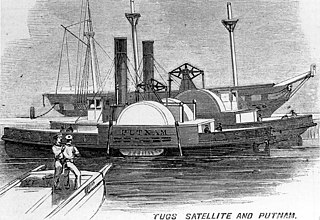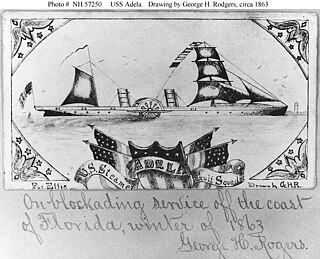USS A. Houghton – a 326 ton bark – was purchased during the beginning of the American Civil War by the Union Navy.
USS New London was a screw steamer of the Union Navy during the American Civil War. She was outfitted with a Parrott rifle and 32-pounders, and was assigned as a gunboat in the Union blockade of the Confederate States of America.
The first USS Sonoma was a sidewheel gunboat that served in the United States Navy during the American Civil War. She was named for Sonoma Creek in northern California, Sonoma County, California, and the town of Sonoma, California, that in turn were named for one of the chiefs of the Chocuyen Indians of that region.

The first USS Seminole was a steam sloop-of-war in the United States Navy during the American Civil War.

USS Kennebec was a Unadilla-class gunboat built for the U.S. Navy following the outbreak of the American Civil War. She was named for the Kennebec River.

USS Satellite was a large, steam-powered large tugboat, acquired by the Union Navy during the American Civil War and equipped with two powerful 8-inch guns. She was assigned to the Union blockade of the Confederate States of America.

USS Jacob Bell was a sidewheel steamer acquired by the Union Navy for use during the American Civil War. She was one of the oldest vessels so acquired. Her duties included river patrols, guard duty, and other duties as assigned.
USS Anacostia was a steamer, constructed as a tugboat, that was first chartered by the United States Navy for service during the Paraguay crisis of the 1850s and then commissioned as a U.S. Navy ship. She later served prominently in the Union Navy during the American Civil War.

USS General Putnam – also known as the USS William G. Putnam – was acquired by the Union Navy during the first year of the American Civil War and outfitted as a gunboat and assigned to the Union blockade of the Confederate States of America. She also served as a tugboat and as a ship's tender when so required.
USS Western World was a ship acquired by the Union Navy during the American Civil War. She was used by the Navy to patrol navigable waterways of the Confederacy to prevent the South from trading with other countries.

USS Octorara was a steamer acquired by the Union Navy during the American Civil War. She was used by the Navy to patrol navigable waterways of the Confederacy to prevent the Confederates from trading with other countries.

USS Aroostook was a Unadilla-class gunboat built for the Union Navy during the American Civil War. Aroostook was used by the Navy to patrol navigable waterways of the Confederacy to prevent the South from trading with other countries.
USS Stepping Stones was a steamer purchased by the Union Navy during the early part of the American Civil War.

USS Adela was a steamer captured by the Union Navy during the American Civil War. She was used by the Union Navy as a gunboat in support of the Union Navy blockade of Confederate waterways.

USS Tahoma was a Unadilla-class gunboat built by order of the United States Navy for service during the American Civil War.
USS Adolph Hugel was a schooner acquired by the Union Navy during the American Civil War.
USS Arletta was a schooner acquired by the Union Navy during the American Civil War. She was used by the Union Navy as a gunboat and, at times, an ammunition ship, in support of the Union Navy blockade of Confederate waterways.
The third USS Union was a heavy (1,114-ton) steamer with a powerful 12-inch rifled gun purchased by the United States Navy during the American Civil War.
USS T. A. Ward was a 284-ton schooner was purchased by the Union Navy during the Union blockade of the Confederate States of America during the American Civil War.

John Cummings Howell was an officer in the United States Navy during the American Civil War. He rose to the rank of rear admiral and late in his career was commander-in-chief of the North Atlantic Squadron and then of the European Squadron.








